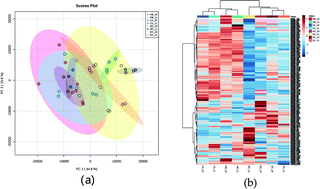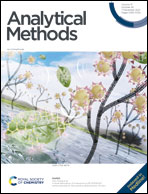UPLC-Q-TOF-MS based metabolomics study of hawthorn leaves in different geographical regions†
Abstract
The quality evaluation of hawthorn leaves in different geographical regions derived from the dried leaves of Crataegus pinnatifida Bge. Var. Major N.E.Br. or Crataegus pinnatifida Bge., a common blood-activating and stasis-eliminating traditional Chinese medicine, has hardly been reported. In this study, the chemical comparison of 40 batches of hawthorn leaf samples collected from Hebei, Liaoning, Shandong and Shanxi Provinces was performed using an ultra-high performance liquid chromatography with electrospray ionization-tandem mass spectrometry-based metabolic profile and pattern recognition analysis approach. A total of 233 compounds were determined. Among them, 40 compounds were selected as potential metabolites responsible for the differential clustering, and the differential metabolite-based evaluation model was applied to well distinguish the origin of seven batches of hawthorn leaves sold on the market. Further analysis of the KEGG pathway showed that five core metabolites containing flavonoids and lignins were mainly involved in flavonoid biosynthesis, flavone and flavonol biosynthesis, and stilbenoid, diarylheptanoid and gingerol biosynthesis. Taking the content of flavonoids, core markers, as the evaluation basis, it was found that the quality of hawthorn leaves in Hebei and Liaoning was better. The study provides a reference for the rational utilization of hawthorn leaves, and highlights that the metabolomics-driven analysis method is more suitable for the quality evaluation of traditional Chinese medicine.

- This article is part of the themed collection: Analytical Methods HOT Articles 2021


 Please wait while we load your content...
Please wait while we load your content...